Abstract
Mouse cells carrying the dominant resistance gene Mx develop a more efficient antiviral state toward influenza viruses in response to interferon than do Mx-negative cells. We have identified an Mx gene-associated product by labeling cultured peritoneal macrophages and embryonic cells with [35S]methionine in the presence or absence of interferon. The radioactive proteins from unfractionated cytoplasmic extracts were separated electrophoretically in two dimensions and were revealed by fluorography. A protein with a Mr of 72,500 and an isoelectric point of 6.3 was induced by mouse interferon type I (a mixture of alpha and beta interferons) in cells carrying the gene Mx but not in cells lacking Mx. The induction of this protein could be blocked by actinomycin D. The maximal rate of synthesis was reached in embryonic cells 4-5 hr after treatment with 10(3) reference units of interferon per ml. When the allele Mx (present in the inbred mouse strain A2G) was repeatedly backcrossed on different genetic backgrounds (BALB/c, C57BL/6, A/J), a clear correlation between the inducibility by interferon of this protein and the presence of the allele Mx was observed. The results suggest that this protein induced by the interaction of interferon with Mx plays a role in the selective antiviral state against influenza viruses that is observed in interferon-treated Mx-bearing cells.
Full text
PDF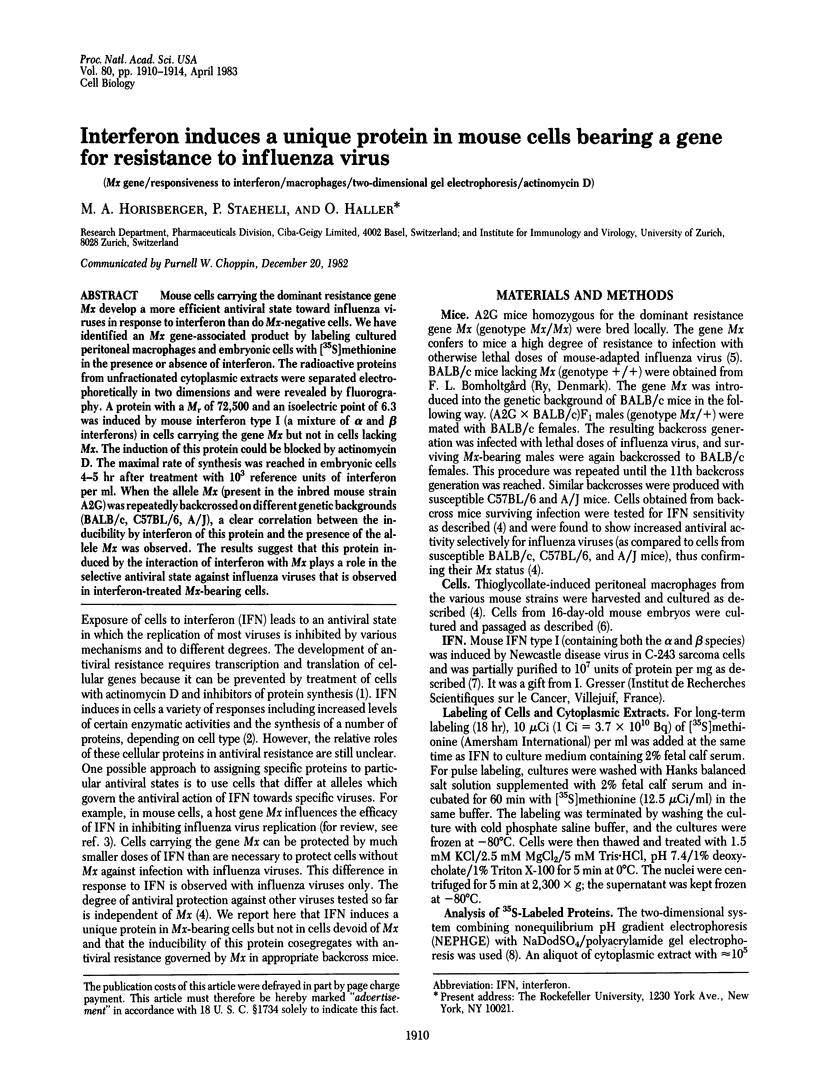
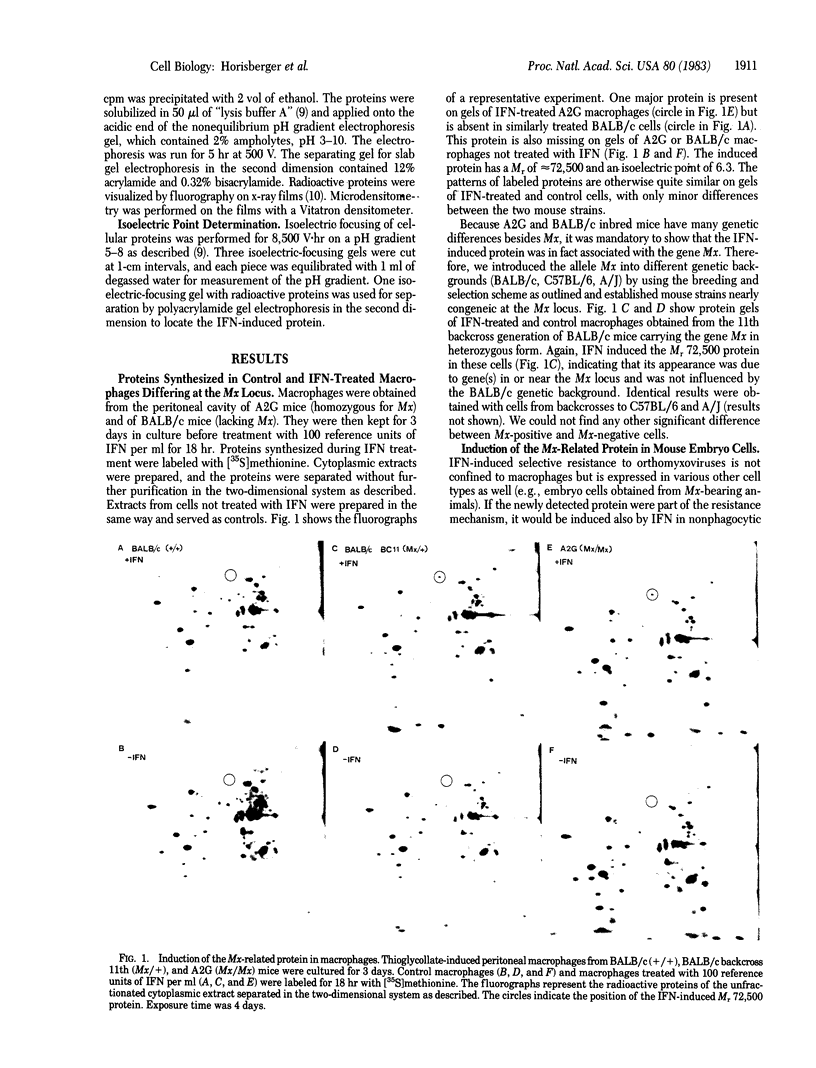
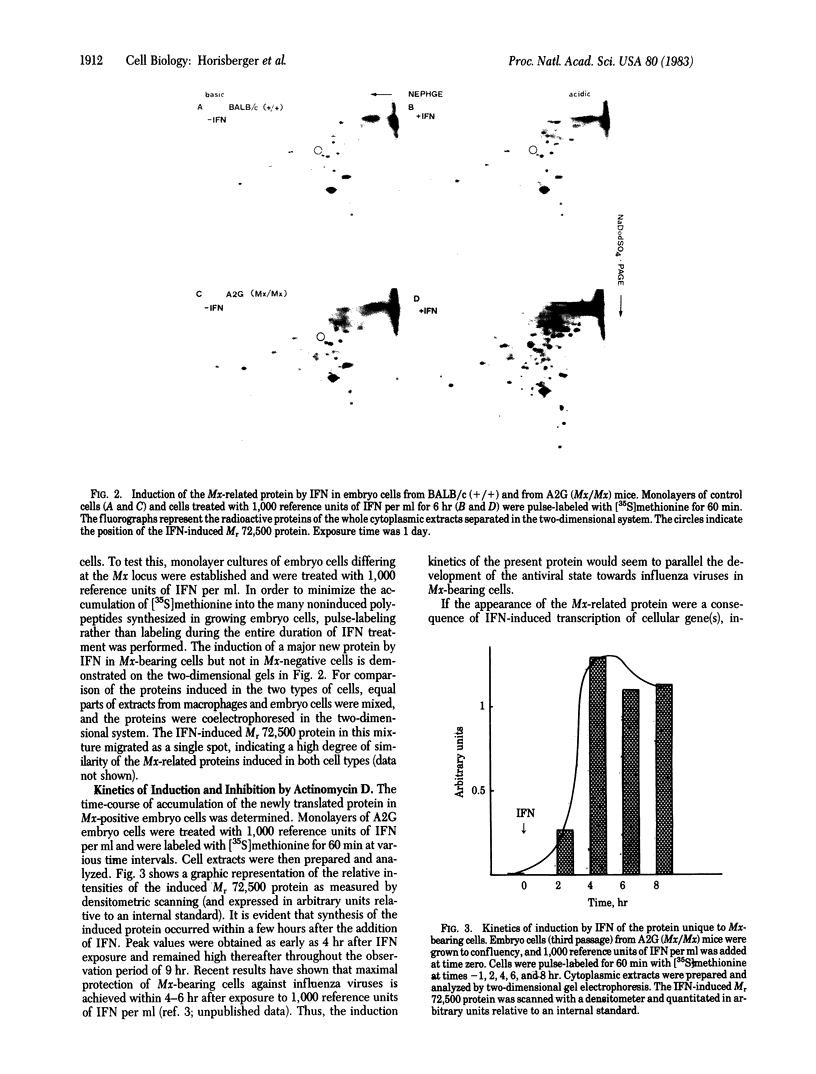
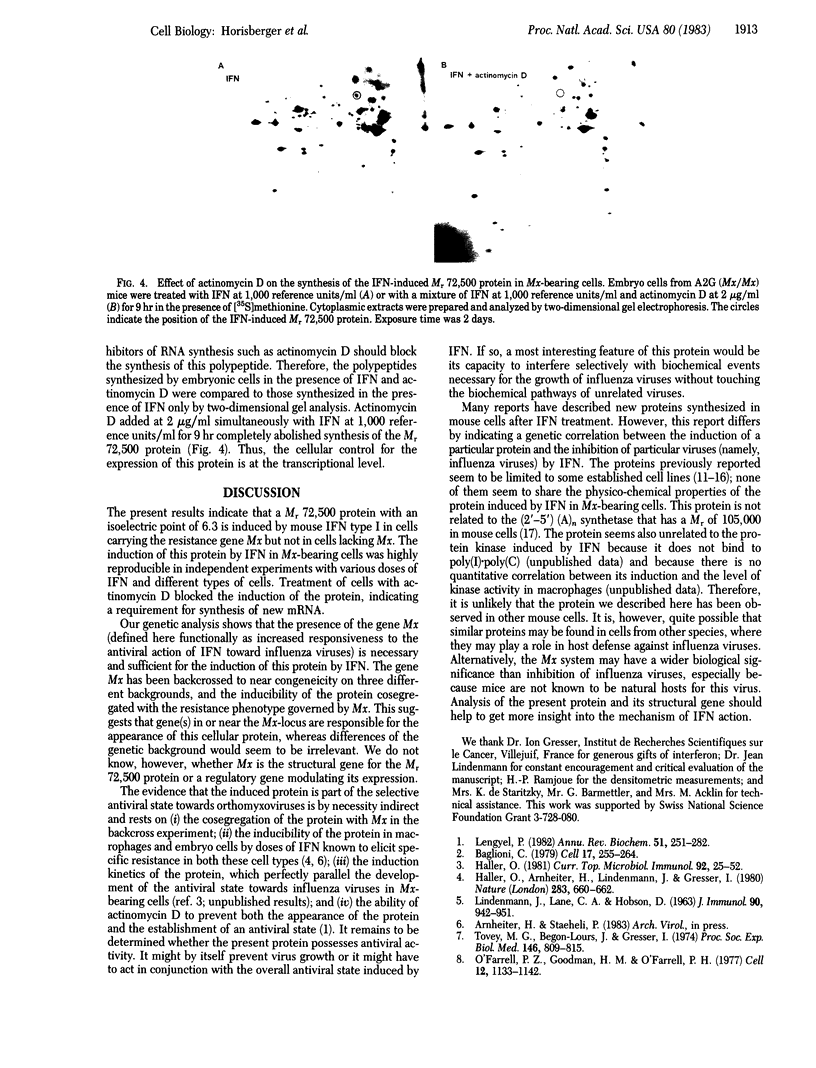
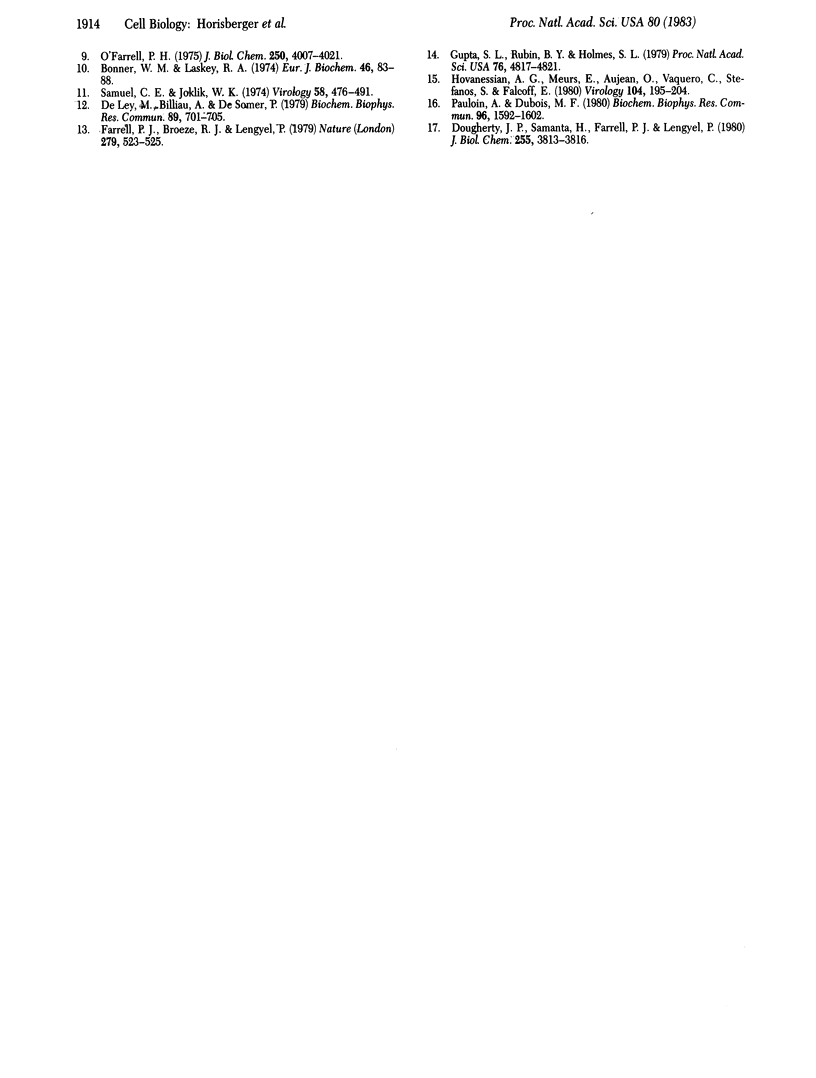
Images in this article
Selected References
These references are in PubMed. This may not be the complete list of references from this article.
- Baglioni C. Interferon-induced enzymatic activities and their role in the antriviral state. Cell. 1979 Jun;17(2):255–264. doi: 10.1016/0092-8674(79)90151-x. [DOI] [PubMed] [Google Scholar]
- Bonner W. M., Laskey R. A. A film detection method for tritium-labelled proteins and nucleic acids in polyacrylamide gels. Eur J Biochem. 1974 Jul 1;46(1):83–88. doi: 10.1111/j.1432-1033.1974.tb03599.x. [DOI] [PubMed] [Google Scholar]
- De Ley M., Billiau A., De Somer P. Interferon-induced synthesis of a 63,000 dalton protein in mouse cells. Biochem Biophys Res Commun. 1979 Jul 27;89(2):701–705. doi: 10.1016/0006-291x(79)90686-7. [DOI] [PubMed] [Google Scholar]
- Dougherty J. P., Samanta H., Farrell P. J., Lengyel P. Interferon, double-stranded RNA, and RNA degradation. Isolation of homogeneous pppA(2'p5'A)n-1 synthetase from Ehrlich ascites tumor cells. J Biol Chem. 1980 May 10;255(9):3813–3816. [PubMed] [Google Scholar]
- Farrell P. J., Broeze R. J., Lengyel P. Accumulation of an mRNA and protein in interferon-treated Ehrlich ascites tumour cells. Nature. 1979 Jun 7;279(5713):523–525. doi: 10.1038/279523a0. [DOI] [PubMed] [Google Scholar]
- Gupta S. L., Rubin B. Y., Holmes S. L. Interferon action: induction of specific proteins in mouse and human cells by homologous interferons. Proc Natl Acad Sci U S A. 1979 Oct;76(10):4817–4821. doi: 10.1073/pnas.76.10.4817. [DOI] [PMC free article] [PubMed] [Google Scholar]
- Haller O., Arnheiter H., Lindenmann J., Gresser I. Host gene influences sensitivity to interferon action selectively for influenza virus. Nature. 1980 Feb 14;283(5748):660–662. doi: 10.1038/283660a0. [DOI] [PubMed] [Google Scholar]
- Haller O. Inborn resistance of ice to orthomyxoviruses. Curr Top Microbiol Immunol. 1981;92:25–52. doi: 10.1007/978-3-642-68069-4_3. [DOI] [PubMed] [Google Scholar]
- Hovanessian A. G., Meurs E., Aujean O., Vaquero C., Stefanos S., Falcoff E. Antiviral response and induction of specific proteins in cells treated with immune T (type II) interferon analogous to that from viral interferon (type I)-treated cells. Virology. 1980 Jul 15;104(1):195–204. doi: 10.1016/0042-6822(80)90377-3. [DOI] [PubMed] [Google Scholar]
- LINDENMANN J., LANE C. A., HOBSON D. THE RESISTANCE OF A2G MICE TO MYXOVIRUSES. J Immunol. 1963 Jun;90:942–951. [PubMed] [Google Scholar]
- Lengyel P. Biochemistry of interferons and their actions. Annu Rev Biochem. 1982;51:251–282. doi: 10.1146/annurev.bi.51.070182.001343. [DOI] [PubMed] [Google Scholar]
- O'Farrell P. H. High resolution two-dimensional electrophoresis of proteins. J Biol Chem. 1975 May 25;250(10):4007–4021. [PMC free article] [PubMed] [Google Scholar]
- O'Farrell P. Z., Goodman H. M., O'Farrell P. H. High resolution two-dimensional electrophoresis of basic as well as acidic proteins. Cell. 1977 Dec;12(4):1133–1141. doi: 10.1016/0092-8674(77)90176-3. [DOI] [PubMed] [Google Scholar]
- Pauloin A., Dubois M. F. Synthesis of two non-phosphorylated proteins induced in mouse L-cells by homologous interferon. Biochem Biophys Res Commun. 1980 Oct 31;96(4):1592–1602. doi: 10.1016/0006-291x(80)91356-x. [DOI] [PubMed] [Google Scholar]
- Samuel C. E., Joklik W. K. A protein synthesizing system from interferon-treated cells that discriminates between cellular and viral messenger RNAs. Virology. 1974 Apr;58(2):476–491. doi: 10.1016/0042-6822(74)90082-8. [DOI] [PubMed] [Google Scholar]
- Tovey M. G., Begon-Lours J., Gresser I. A method for the large scale production of potent interferon preparations. Proc Soc Exp Biol Med. 1974 Jul;146(3):809–815. doi: 10.3181/00379727-146-38196. [DOI] [PubMed] [Google Scholar]





